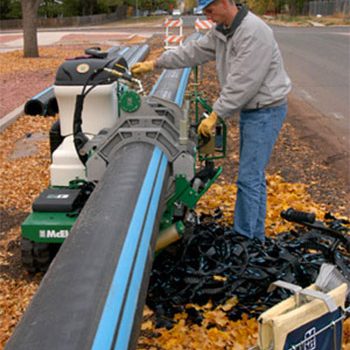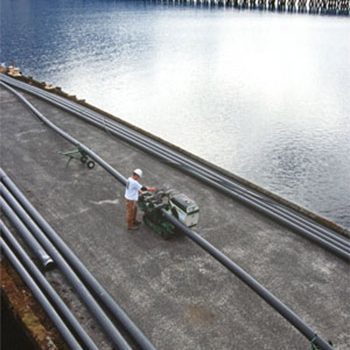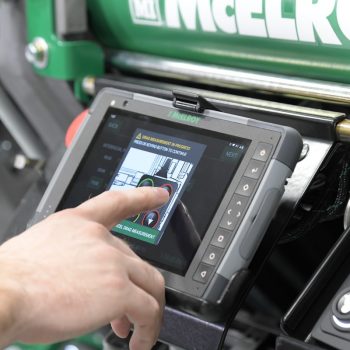I push my way through the mass of people gathered in the pipe warehouse in search of Ryan Harrington. I find him surrounded by a group of 120-some-odd men who are shouting answers to pipe fusion questions with the enthusiasm of Ron Popeil’s studio audience. Harrington is flinging hats and shirts at them like a cheerleader at a football game and the whole scene looks more like a pep rally than a polyethylene, fusion-training seminar. The men are a mix of ditch-diggers, civil engineers, and water managers along with a couple of mayors. They have come from all over Oklahoma to an ISCO Industries facility in the tiny town of Pryor, OK, to get free fusion training.
Harrington’s job description entails everything from right hand man of ISCO’s President, to marketing manager, fusion trainer, chief bottle washer and tee shirt distributor. He is in the middle of a nationwide dog and pony show to educate and train anyone who will listen to him about high-density polyethylene pipe (HDPE), how to fuse it together, and why he believes it is the best pipe in the world.
Potential solution
The traveling seminar was inspired by the broad need for trained fusion technicians to heat weld together HDPE pipe. The HDPE surge is coming from water and wastewater managers who are buying into the belief shared by ISCO – and a slew of others – that HDPE pipe should play a major role in solving the nation’s looming water and wastewater crisis.
The old mind-set that water is plentiful and cheap has finally received a much needed attitude adjustment following a nationwide drought along with pipeline leaks and failures that have polluted waterways. The leaks have hit pipeline owners and communities to the tune of billions in lost revenue. The biggest problem of the worn out infrastructure is that it has wasted untold volumes of what is arguably the most precious resource the world has to offer-water.
“These problems are catapulting water to the forefront of public awareness,” says Harrington. “They are learning what water companies and the pipeline industry have understood for a long time. Our piping infrastructure is in horrific shape.”
They are learning what water companies and the pipeline industry have understood for a long time. Our piping infrastructure is in horrific shape.
Soaring rehab costs
EPA data backs this up and says the U.S. water infrastructure is in need of rehabilitation in the $150 billion range but many in the industry put the figure much higher.
The sewer infrastructure is no better. In a report to Congress, EPA stated that $181.2 billion is needed immediately for the nation’s centralized sewage collection and treatment infrastructure. EPA says that, without considerable investment, by 2025 U.S. waters will again suffer from sewage-related pollutant loadings that are as high as they were in 1968-the highest in the nation’s history.
The public is voicing its opinion that this is no longer an out-of-sight, out-of-mind problem. According to a recent Frank Luntz Survey, 72 percent of respondents are either extremely or very concerned about clean water. Americans consider water a major health concern and the survey shows that 83 percent of Americans would support legislation to create a long-term trust fund for clean water-much like the trust fund set up for roads and bridges.
Market share explosion?
ISCO’s President Jimmy Kirchdorfer thinks that these problems are the catalysts that will bring polyethylene into America’s water and wastewater infrastructure in a big way. A major part of the trouble is leakage and the biggest source for leakage is the weakest part of the piping system-the joint. HDPE has no joint. Polyethylene is heat fused together by melting the pipe ends and forcing them together. The result is a union that is stronger than the pipe itself. In destruction testing, the pipe breaks 100 percent of the time in a place other than the fused region. The result is a piping system that is truly monolithic with no joints. Since corrosion and joint failure are the cause of most leaks, and polyethylene doesn’t corrode and has no joint, Kirchdorfer feels it is the pipe to solve the leakage problem and his mission is to tell anyone who is willing to hear him.
“The problems that are plaguing us are going to bring America’s infrastructure up to 21st Century standards and technologies,” said Kirchdorfer. “Polyethylene is a superior product. It is a state of the art piping system that is perfectly suited to combat the quandary we all face and ISCO is banking on it.” Kirchdorfer’s belief is that HDPE is going to take the water and sewer market by storm and anyone peddling the black pipe has an opportunity to earn a share of the billions needed for infrastructure rehabilitation.
Right now, HDPE only claims about 3 percent of the water infrastructure market. Some think, however, that the U.S. is about to go through the same osmosis that Europe experienced in the 90s when polyethylene climbed from almost no market share to over 80 percent domination in about a decade.
Recent pipe sales indicate a spike for polyethylene in the U.S. but nowhere near the complete material reversal that took place in Europe during the 90s. However, the largest growth in polyethylene pipe sales has come from water pipe. It has jumped from 16 to 21 percent in total polyethylene pipe market distribution from 2001 to 2003. For the first half of 2004 water pipe took a large jump and is up 13 percent over the 2003 mark. Perhaps the biggest indication of polyethylene growth is that the membership for the Plastics Pipe Institute (PPI) has almost tripled since 1999. PPI is the major trade association representing HDPE and other segments of the plastics piping industry.
Betting on a winner?
“We’ve leveraged everything we have that polyethylene is the pipe of the future,” Harrington said a few months ago after training almost 2,000 students in 14 states. “We’ll do almost twice as much business as we did last year,” he said.
Kirchdorfer not only believes the HDPE market is going to grow tremendously, he is putting his money where his mouth is and has added 10 new locations across the country, doubled his workforce and is constantly searching for new places on which to hang his shingle. He is sending the message that he is a major player in the pipe business and is on a mission to serve the needs of anyone who is considering HDPE.
“What bigger decision could a civil engineer make than the decision to change piping material?” Kirchdorfer asks from the middle of his pipe yard in Louisville. His home office sticks out like a sore thumb on a street lined with 11 bars. It is a sign that ISCO has been there for a while and if Kirchdorfer ever decides to go into the honky-tonk business, he already owns some prime real estate. Not likely when I realize his focus and intensity makes me feel like he probably goes to bed at night and only dreams of polyethylene pipe. “There is no bigger decision for a civil engineer in a 40 year career, than the decision to change piping material. The progressive ones who take that giant step want to work with someone on a local level who knows a lot about HDPE.”
Educating non-believers
Kirchdorfer is frustrated that the market is not growing faster and feels ISCO’s job is to help in the education process. “Civil engineering firms cut their teeth on other materials. It’s easier for them to design with other materials,” said Kirchdorfer. “But the ones that really want to bring a better product and piping system to their clients are reaching out to learn more about HDPE.”
Polyethylene has piggybacked its way into the water and sewer market on the back of trenchless technology. It has mostly just been used under rivers and roads where future leaks would be devastating and extremely expensive to fix.
“We see HDPE piping going into more municipal water systems than ever before,” said Will Bezner, PE Technical Services Manager of Rinker Materials PolyPipe. Rinker is the largest independent polyethylene pressure pipe manufacturer in North America. Bezner points out that the tough, flexible nature of HDPE makes it the material of choice for trenchless installation techniques that many municipal operations are taking advantage of.
Kirchdorfer also credits trenchless technology with bringing HDPE to water systems. “Trenchless technology has gotten us in the door to a lot of places that never considered using HDPE,” said Kirchdorfer. “The success rate of those projects creates a snowball effect and once they see that HDPE can handle their toughest jobs, they understand the value in using it for the rest of their applications.”
Indianapolis Water is a perfect example of a city that first tried HDPE for trenchless applications in 1992. Now they are considered the HDPE pioneer for water utilities. Today they use it for rehabilitation and new construction. Other cities in the country are calling on them to learn about their successes.
Advantages of HDPE
St. Petersburg, FL, is at present in the process of implementing an 18-year $100 million program to replace and upgrade the city’s aging water system infrastructure with predominately HDPE. Many of the areas in St. Pete have been classified as historical preservation areas with brick streets, granite curbing and hex block sidewalks. Removal and restoration of these assets using conventional open cut construction techniques comes with a considerable price tag. This is where St. Pete uses trenchless methods and HDPE to reducing the number of concerns from area residents and homeowner associations.
“To compare HDPE with other materials solely on price per linear foot is not a proper comparison,” said Joe Towry, manager of the Water Systems Maintenance Division for the City of St. Petersburg. “Other items should be taken into consideration like the long-term investment. Leaks are expensive. If I can spend an extra three dollars today that will save the city $100 in the future, I have done my job well.” Towry also points out that many fittings and thrust blocks are eliminated saving additional money because of the pipe’s flexibility.
City officials of Colorado Springs Utilities (CSU) joined together their three separate departments – gas, sewer and water – to embrace trenchless technologies and HDPE. Their thinking is that trenchless techniques and HDPE have been used for years in the gas department and would work well for the water and sewer departments. By doing this, they combined all of the departments and reorganized so that construction and maintenance includes all three utilities under one heading. Moreover, the city is heavily using HDPE for water and sewer and their evolution has spread to nine communities in the surrounding area.
“Polyethylene is what is going to happen to the waterworks business,” said Don Cole, executive vice president of Mountain States Pipe & Supply, the water house responsible for helping CSU convert to HDPE. “Of all the piping that is currently available in the lower pressure classes, HDPE has the most going for it. No cathodic protection is required, you can do most of the assembly out of the ditch, no thrust blocks or joint restraints are required, and its totally leak free. This material has found a home in water works.”
The government is moving to HDPE in a few pilot projects starting with military bases. Fort Carson, on the outskirts of Colorado Springs, houses 18,000 people and is currently undergoing a complete rehabilitation of its water system. It will be a totally fused HDPE system. It is a pilot project for the Corps of Engineers because many of the military bases across the country are in dire need of the same kind of rehabilitation.
Another government job is a water project for a Job Corp Base in Astoria, OR. There are 118 Job Corp sites spread around the country and most of them are located on abandoned military bases built shortly before or during World War II. Their piping infrastructures are in the same condition the rest of the military bases are in, and for the job in Astoria, 10 students were trained to become certified fusion operators while the job took place. Job Core will measure the success of these students in gaining employment in the pipe fusion industry and will then considering making pipe fusion one of the trades taught at their bases.
“We’ve made a big investment by expanding and we’re proud to be selling the best piping solution available,” said Kirchdorfer. “Having our sales engineers providing education to local decision makers face-to-face is the only way HDPE is going to break into the water market and the whole industry is going to benefit from our legwork. But in the end, the greatest benefit of an HDPE water and wastewater system is the local population and the next generation.”



